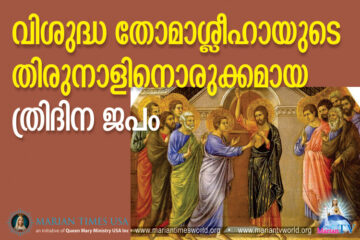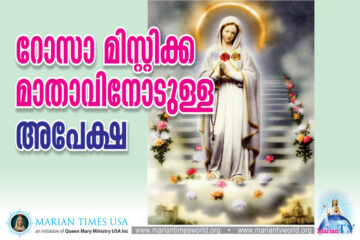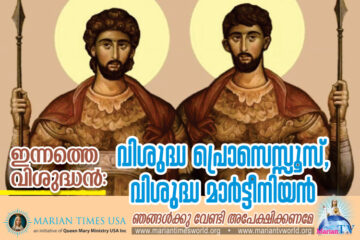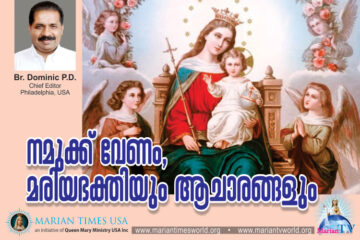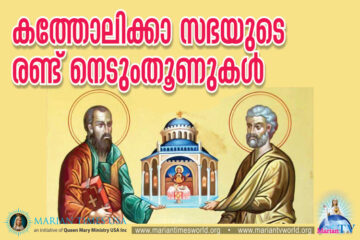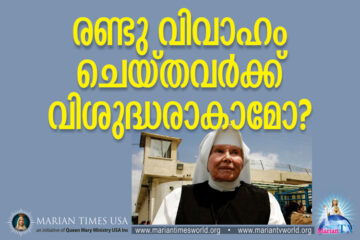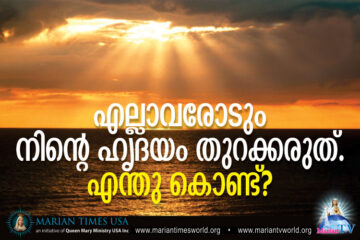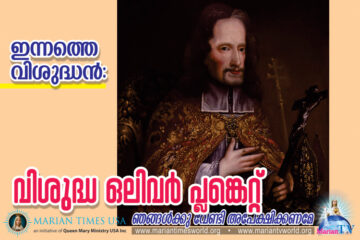DUKHRANA OF ST. THOMAS THE APOSTLE
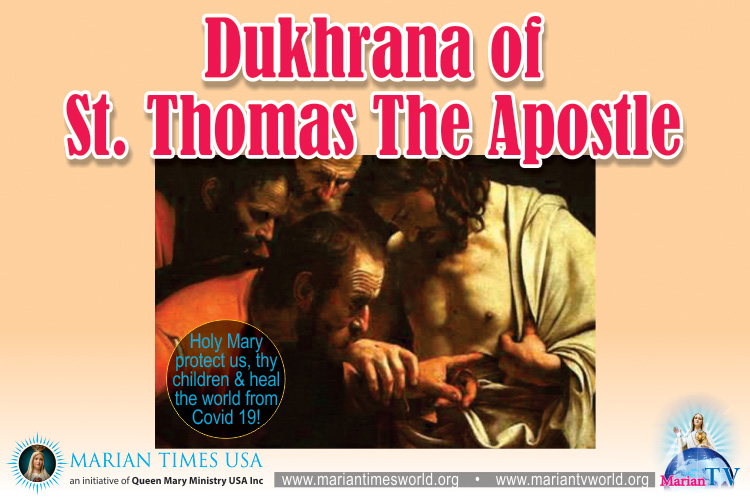
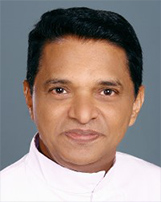
Fr. Abraham Mutholath,
Chicago USA
(July 3)
INTRODUCTION
St. Thomas was born in a Jewish family in Galilee and was a builder like St. Joseph. He followed Jesus and became one of the twelve Apostles. His date of birth is unknown, and his date of death is 21 December, 72 AD. Church used to celebrate his feast on December 21st. It is now on July 3rd known as Dhukrana which means remembrance. St. John the Evangelist gives three interactions of Thomas with Jesus which are all communicative of Thomas’ commitment to Jesus and his ministry. Thomas was the only apostle who preached outside the Roman Empire. Along with other countries, he also preached in India and faced martyrdom there. Though his burial was in Mylapore, the church moved major parts of his remains to Edessa and Italy.
Name
The original name of St. Thomas, according to tradition, is Judas Thomas or Judas the Twin. The literal meaning of Thomas is twin originated from Te’oma in Aramaic and Didymos in Greek (John 11:16). St. Thomas had a twin brother or sister. According to the Syriac tradition, believers call St. Thomas as Mar Thoma Sleeha which means Lord Thomas the Apostle.
In the Gospels
Synoptic gospels and the Acts of the Apostles list Thomas along with the other apostles (Matthew 10:3, Mark 3:18, Luke 6:15, Acts 1:13). However, John’s gospel presents St. Thomas’ personality at three occasions.
The Committed Apostle: News came to Jesus that Lazarus, one of his exceptional friends, who hosted him several times during his journey to Jerusalem, was sick. Later Jesus revealed to the disciples that Lazarus had died, and Jesus expressed his wish to visit his family. The apostles were afraid to go to Jerusalem because the Jews had tried to stone Jesus to death (John 11:8). While they discouraged Jesus from going ahead, Thomas came forward and said to the other apostles, “Let us also go that we may die with him.” (John 11:16). Thomas was so committed to Jesus during his public ministry that he was even willing to die with Jesus. And he empowered the others also to do so even before they received courage from the Holy Spirit.
The Curious Learner: A enquiring student would inquire the teacher to clarify the unknown mysteries. St. Thomas was such a curious learner. During the last discourse to his disciples at the last supper, Jesus said to them: “You know the way to where I am going.” (John 14:4). The apostles did not know what Jesus meant. While others were reluctant to ask for clarification because of fear of how the master would react, Thomas showed the boldness to ask Jesus representing all the disciples, “Lord, we do not know where you are going; how can we know the way?” (John 14:5). That gave the opportunity for Jesus to clarify, and a privilege for others to hear from Jesus, a significant mystery of Jesus in his words, “I am the way, the truth and the life; no one comes to the Father except through me.” (John 14:6). Basing on that, Thomas taught about Jesus as the way to the Father. So, the public called the Christians who inherited faith from Apostle Thomas as “Margam koodiyavar” (Those who joined the way).
A Convinced Believer: A negative title attributed to St. Thomas is “Doubting Apostle.” The Risen Lord appeared to his disciples in the Upper Room on the evening of the first day of his resurrection. All the apostles, except Thomas and Judas Iscariot, were present. The reason for Thomas’ absence is unknown. Probably, he wanted to express his grief in solitude, or as a courageous person, he went outside to study the situation. Anyway, Thomas missed that exciting experience of seeing the Risen Lord, the privilege to receive Holy Spirit from Jesus through his breathing over the apostles, and the commissioning of the apostles to continue his mission: “he showed them his hands and his side. The disciples kept looking at the Lord and were full of joy. Again Jesus said to them, ‘Peace be with you. As the Father has sent me, so I am sending you.’ And with that he breathed on them and said to them, ‘Receive the Holy Spirit. If you forgive people’s sins, they are forgiven; if you retain people’s sins, they are retained.’” (John 20: 20-23).
When the apostles shared their experience of seeing the Risen Lord with excitement, it was heartbreaking for Thomas because of his loss of a precious opportunity. Thomas knew that the disciples were telling the truth. But, out of his downheartedness, he demanded the same experience for him to believe in Jesus’ resurrection. Thomas realized his mistake of not continuing the companionship of the disciples in prayer. Though he expressed his anguish, he did not give up the communion of the apostles. When Jesus appeared to the disciples on the next Sunday, Thomas was with them and could get personal attention from Jesus who invited him to touch his marks of wounds. Thomas’ insistence became an added proof to the world on the Lord’s resurrection. He also gave a great theological expression, “My Lord and my God!” Thomas expressed and taught to the world the divinity of Jesus: The Lord Jesus is also the Almighty God. Thomas was not a blind believer but a convinced faithful. After receiving the Holy Spirit on the day of Pentecost, Thomas boldly presented Jesus to the people outside the Roman Empire.
Missionary Expeditions of Thomas
Jesus had selected and trained apostles and other disciples as a succession plan to continue his mission. The Acts of the Apostles describe the missionary expeditions of St. Paul and St. Peter and others. However, we have little written records on the missionary journey of St. Thomas, except in some non-canonical books. According to Eusebius, Thomas had preached in Parthia (North-Eastern Iran) and India. Some Eastern Churches in China and Japan claim that St. Thomas brought Christianity to China in 64 and Japan in 70 A.D.
There are some writings and traditions on the missionary work of St. Thomas in India. He reached Muziris (Kodungalloor in the present Kerala State) in 52 A.D. There was a Jewish community there during that time. St. Thomas established seven and a half churches in the present Kerala. They are at Kodungalloor, Palayoor (Chattukulangara), Kataoka (Paravoor), Kokkamangalam, Nirupam, Nilackal (Chayal), Kollam and Thiruvithamcode (Travancore), the half church. Thomas baptized several families including Pakalomattom, Sankarapuri, Kalli, Kaliyankal, Nedumpilly, Panakkamattom, Kunnappilly, Vazhappilly, Payyappilly, Maliakkal, Pattamukku and Thaiyil. Some other families also claim to have their Christin origin during this time.
A third century Syriac writing, known as the Acts of Thomas, presents a story on the missionary work of Thomas in India. According to the legend, the apostles drew lots to divide the world for their missionary work. Thomas got India by lot and he was reluctant to go there. However, Jesus appeared to him in a vision and reassured him of his support. Meanwhile, Abbanes, a merchant and representative of the Indo-Parthian king Gundaphorus came to Jerusalem searching for a carpenter to build a palace for his king in India. Jesus appeared to Abbanes and “sold” Thomas as a carpenter. Thomas, realizing the wish of Jesus, went to India with Abbanes. The King Gundaphorus was the ruler of present Afghanistan, Baluchistan, Punjab, and Sind from the year 20 to 46 A.D.
Gundaphorus entrusted plenty of money to Thomas to build a magnificent palace for him. Thomas preached the gospel and helped the poor with the money he received from the king. Realizing that Thomas was “misusing” him money and not building the palace, the king summoned Thomas and questioned him. The reply of Thomas was that he was building the palace in heaven with the money and the king can occupy it after his death. The king who thought Thomas cheated him, imprisoned Thomas.
While Thomas was in prison, the kings brother Gad died. Realizing that Thomas was a miracle worker, king brought Thomas from prison to pray at the body of his brother. At the prayer of Thomas, Gad came back to life. He explained to the king that while dead, he saw a beautiful palace that Thomas built in heaven for the king. King Gundaphorus prostrated in front of Thomas and apologized for his mistake. This incident led to the king’s conversion and many people in his kingdom.
Writings attributed to Thomas
The Gospel of Thomas, the Acts of Thomas, and the Infancy Gospel of Thomas are the books attributed to St. Thomas. However, the church does not approve the authorship of Thomas or accept them as canonical books. It considers the Gospel of Thomas as of gnostic origin and heretical.
Apostle Thomas sent letters from Taxila and Malabar in India to the Church in Edessa. The church in Edessa read the letters during the liturgy and preserved them for later use. Though St. Thomas did not preach in Edessa, he sent his disciple Mar Addai for evangelization in Edessa. The letter readings from Thomas during Sunday services developed a bond between Thomas and the church in Edessa. Christians in Edessa considered St. Thomas as their apostle. Since the Christians in Edessa felt close to St. Thomas, they transported the bones of St. Thomas from Mylapore to Edessa on July 3, 232.
The letters of St. Thomas in Aramaic language to the Church of Edessa were not spread to other churches or did not enter the New Testament because they were more a newsletter than a letter of spiritual instruction. They were valuable to the church in Edessa because it was from their favorite apostle and they were addressing them. So, they preserved them along with other precious manuscripts of gospels and epistles in their church. A flood from River Daisan in 201 destroyed these documents along with the church that preserved them.
Thomas, as Eyewitness of B.V. Mary’s Assumption
Traditional belief is that, Thomas saw the Blessed Virgin Mary’s assumption into heaven. A text attributed to Joseph of Arimathea called “The Passing of Mary” gives a legend on this. According to this document, when the Blessed Virgin Mary was nearing death, angels appeared to all the apostles asking them to visit the Blessed Mother before her death. All of them, except Thomas, saw her death and burial. Since Thomas was in India, he could reach only on the third day after her death. Because Thomas insisted, people opened the tomb of Mary. It was an empty tomb. When Thomas raised his eyes, he witnessed Mary’s bodily assumption into heaven, and she dropped her girdle to Thomas. The other apostles, hearing the story, came back and saw the empty tomb of Mary and the girdle that Thomas received. The pre-Tridentine and medieval art depict Thomas receiving the girdle. Pope Gelasius I pronounced “The Passing of Mary” as a heretical document in 494.
Martyrdom
Like the other apostles, Thomas could perform many miracles by the grace of God to help and convince the people to embrace Christianity. According to the legends, Thomas performed many such signs in Syria, Persia, and India. One among the converts was the wife of the King of Mylapore in Madras.
The King summoned Thomas in 72 A.D. and asked him to offer sacrifice to an idol. When the reluctant Thomas approached the idol, it got shattered into pieces. The furious king ordered the high priest to kill Thomas. After condemned to death, four soldiers pierced Thomas with spears at hillock now known as St. Thomas Mount. The Christians constructed San Thom Cathedral at his burial place.
Transportation of Relics
According to some writings and traditions, when Vasudeva I was the Kushan emperor in India, merchant Khabin transported the bones of St. Thomas from Mylapore to Edessa on July 3, 232. The relics worked many miracles in India and Edessa. Acts of Thomas was written in Syriac during this time. The relics of St. Thomas was moved from Edessa to various other places later. A sailor Leone Acciaiuoli took some relics of Thomas in 1258 to the Church of Saint Thomas the Apostle at Abruzzo in Ortona, Italy. There is another tradition that the skull of the saint is in the Monastery of Saint John the Theologian on the Greek Island of Patmos.
Feast days of St. Thomas
According to the Roman calendar of the 19th century Thomas died on December 21. So, the church celebrated the feast of St. Thomas on that date. The church transferred this feast to July 3rd in 1939 because St. Jerome in his Martyrology mentioned that as the date of Thomas’ martyrdom. The church transferred the remains of St. Thomas from Mylapore to Edessa on July 3, 232. So, St. Thomas’ feast has a link to that date. Transferring the feast from December 21st to July 3rd is helpful for better observance of advent. Traditionalist Roman Catholics and many protestant churches still celebrate St. Thomas feast on December 21st. The Eastern Orthodox and Byzantine Catholic churches celebrate the feast of St. Thomas on October 6th. The church also celebrates the Sunday after Easter as the feast of St. Thomas to remember St. Thomas proclaiming his faith in the Risen Lord by saying, “My Lord and my God.” The Malankara Orthodox church celebrates three feasts of St. Thomas: on July 3rd remembering the transfer of relics to Edessa, on December 18th the day the extremists lanced Thomas, and on December 21st the day he died.
Patron Saint
St. Thomas is the patron ofdoubtful people, blind people, architects, builders, carpenters, construction workers, geometricians, stone masons, surveyors, theologians; and places such as Certaldo, Italy, India, Indonesia, Pakistan, and Sri Lanka.
The artists depict Saint Thomas as a youthful man holding a scroll, or as a young adult touching the resurrected Christ’s wounds.
MESSAGE
- While Jesus expressed his wish to visit the house of Lazarus at his death, Thomas encouraged other apostles to go with Jesus even if that would lead to their martyrdom. Though Thomas failed in this at the time of the crucifixion of Jesus, he accepted the martyrdom for Jesus. Let us also find the courage to continue the evangelization of Jesus even at the risk of losing our life.
- Apostle Thomas was instrumental in Jesus’ revelation that he is the way to the Father. Thomas also taught this way to people of many nations. Let us also accept the way of Jesus as the only way to the Father and never get deviated from it.
- Though St. Thomas missed the opportunity to see the Risen Lord on the first day of Resurrection along with other apostles, he did not give up his faith. He remained praying with the group. That gave him an opportunity to experience the Risen Lord. Thomas compensated his lack of faith through his expression of “My Lord and My God.” We also might have difficulties in our spiritual journey. However, we should never give up our faith and hope in the Lord.
- According to the Acts of Thomas, the apostle taught the Indo-Parthian king Gundaphorus the need for storing treasures in heaven with the resources of this world. Thomas risked his life to teach that lesson. Let us also follow that teaching of Jesus Thomas promoted in our life.
- Though all the apostles saw the ascension of Jesus to heaven, only Thomas had the privilege to witness the Blessed Mother’s assumption. Like the post-resurrection experience, God compensated the missed opportunity of Thomas seeing the Blessed Mother at the deathbed, by allowing him to see her assumption. So, like Thomas added a proof for Jesus’ resurrection, Thomas became instrumental promoting the faith in the Blessed Mother’s assumption. Let us also honor the Blessed Mother and seek her intercession in keeping up our faith.
മരിയന് ടൈംസിലെ ഇന്നത്തെ പ്രധാനപ്പെട്ട അപ്ഡേറ്റുകള് താഴെ ലഭിക്കുന്നതാണ്.


